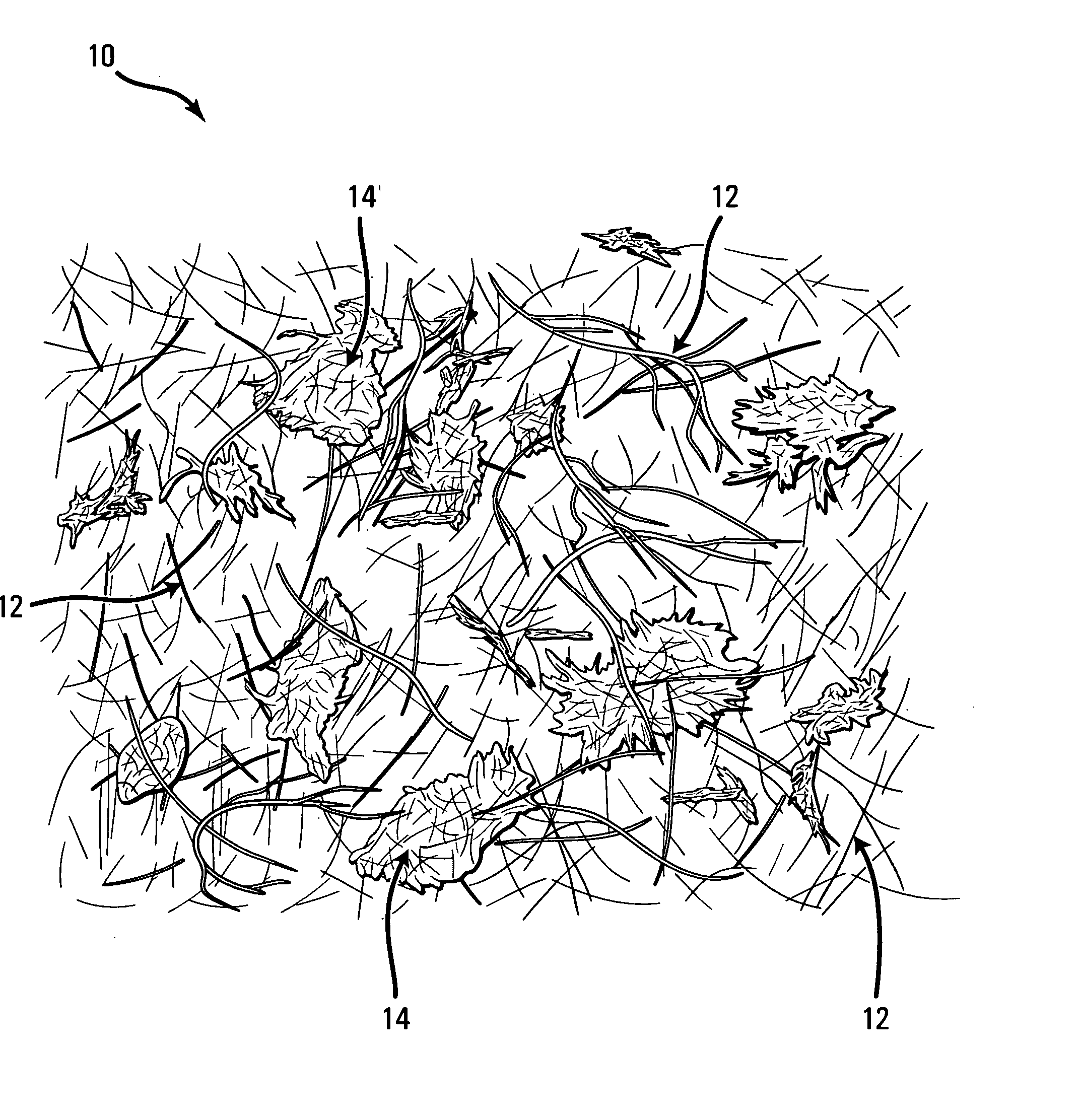Blended mulch products for spray application to a surface
a mulch product and surface technology, applied in the field of mulch products, can solve the problems of poor ground coverage of paper-based mulches, clogging of hoses and nozzles of hydromulching machines, and affecting the operation of pumps, so as to achieve good surface coverage and high loading rate
- Summary
- Abstract
- Description
- Claims
- Application Information
AI Technical Summary
Benefits of technology
Problems solved by technology
Method used
Image
Examples
example 1
Fiber Classification
[0083] The two types of materials used in the blends were classified based on the percentage retention on a screen mesh (Table 1) using the Ro-Tap fiber classification method. These fiber classification tests use Standard Wire mesh screen sizes, where the mesh sizes are inversely proportional to the size of the holes in the screen. Briefly, a 5 gram sample of each material was placed on the top screen of a stack of 8 inch diameter screens, layered such that the largest opening screen was on the top. The screen sizes were 10-, 20-, 40-, 60-, 80-, 100-, and 200-mesh, with pan to catch the undersized 200-mesh material. The screen stack was placed in a Ro-Tap testing sieve shaker and allowed to run for 25 minutes. The retained material on each screen was weighed and percentage retained of total weight was calculated. Each size fraction was described using a range and to detail the fiber size distribution (Table 1). The percent retained by each mesh size will prefera...
example 2
Fiber Lubricity Test on Untreated Fibers
[0085] To quantify the lubricity of the fibers in solution, a 7 gram sample of fiber (based on 12% MC) was placed into 300 milliliters of tap water at ambient room temperature. The material was stirred with a spoonula and rated against two known fibers—a very finely ground refined wood fiber (VFO) (screened fiber is +28 Mesh is 35% to 45% of total weight) available from Canadian Forest Products Ltd., Product Number 3-F3-45), that was rated a 1, and a 50% blended mulch product of refined wood fiber and 50% cellulose paper known for its high loading characteristics, that was rated a 10. The fiber lubricity rating of 10 indicated that slurry was easier to stir because of less interaction of the fibers between one another. The lubricity test was conducted on the refined softwood fiber, hogged hardboard sawtrim and various blends. No surfactant was used to treat the fibers.
TABLE 2Lubricity TestSampleRatingVFO150% Wood / 50% Paper10Sawtrim12Product...
example 3
Fiber Lubricity Test on Treated Fibers
[0087] Various concentrations of Pluronic 25R2 surfactant was used to treat the Product 17 refined fiber. The treated fiber was blended with different levels of untreated sawtrim and the fiber lubricity test was conducted on the blended samples.
TABLE 3Concentration ofLubricity TestSampleSurfactant on Product 17RatingVFO—150% Wood / 50% Paper—1050% Sawtrim / 50% Product 1701050% Sawtrim / 50% Product 170.11150% Sawtrim / 50% Product 170.21250% Sawtrim / 50% Product 170.312
[0088] Table 3 illustrates the results showing that with a surfactant, the lubricity of the fibers increases to a 12 from an untreated fiber lubricity rating of only 10.
[0089] As can be seen from Examples 2 and 3, at loading rates greater than 1300 lbs fiber per 3000 gallons of water, if a refined wood fiber is used alone, the fiber can tend to form a mass which creates difficulties for the high pressure pump to operate and for the material to flow out the hose and be sprayed through ...
PUM
| Property | Measurement | Unit |
|---|---|---|
| density | aaaaa | aaaaa |
| diameter | aaaaa | aaaaa |
| density | aaaaa | aaaaa |
Abstract
Description
Claims
Application Information
 Login to View More
Login to View More - R&D
- Intellectual Property
- Life Sciences
- Materials
- Tech Scout
- Unparalleled Data Quality
- Higher Quality Content
- 60% Fewer Hallucinations
Browse by: Latest US Patents, China's latest patents, Technical Efficacy Thesaurus, Application Domain, Technology Topic, Popular Technical Reports.
© 2025 PatSnap. All rights reserved.Legal|Privacy policy|Modern Slavery Act Transparency Statement|Sitemap|About US| Contact US: help@patsnap.com


